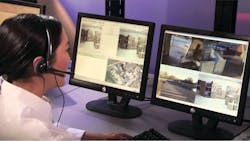Video Trends & Technologies: Finding RMR in Video Verification
Video verification is an opportunity to differentiate your alarm company from your competitors and create additional recurring revenue. For my commercially oriented alarm company, for example, the number-one source of new RMR is video verification. If you want to gain additional RMR from the work you are already doing, then include video verification in your proposals and sales presentations every time.
How do you get started? Simple — get focused. Pick a specific market segment, with a specific assembly, and go to work. You can stand out in your market by including video verification.
Barriers to Widespread Adoption
One factor that has been presented as a major barrier to adopting video verification is that we could be creating two tiers of customers with this type of service. I do not think this is an effective argument because we all have many tiers of customers and service offerings. At my alarm company, we overcame this by presenting video verification as an enhancement or add-on to our existing and new clients.
Another barrier is that video verification has been hard to provide — it required expensive gear, lots of bandwidth, and the central stations did not easily integrate with the offerings. This is no longer true and the dealer has many opportunities to add video verification to the work they are already doing for their clients. Whether it is a dedicated video verification system, such as Videofied (easy to install and to add to existing installations) or adding video verification services to DVRs, NVRs or IP cameras, it is now simple to add, is bandwidth friendly and is cost-effective to provide.
I think the more complex barrier to adoption has been the mindset of our industry. As I have attended industry meetings over the years, you could almost see the imaginary pitchforks as people described their feelings on this topic in the past; however, I no longer experience this in my travels and I think that our industry is on the verge of a new era of alarm verification. I believe this will lead to more RMR for the dealer, faster alarm response, less property loss and safer clients.
How to Sell Video Verification
Whether you have been selling some version of video verification (mostly outdoors, right?) or just beginning, my strongest suggestion is to get focused bypicking a market or market segment. We have focused on small businesses and indoors with my alarm company, but we offer and add video verification to all of our proposals.
Once you have picked your market, the next step is to pick your assembly. This can be influenced by your current video and intrusion offering, or you can design the offering specifically for your chosen segment. Either way, you need to work out the assembly, customer pricing and creation cost. With large systems, we mark up the system design the way we traditionally have and add the monthly fee for video verification. With small systems, we have a three-camera package or assembly that we lose money on and it takes about 12 months to recover our direct costs.
I am seeing dealers across the country add between $35 to $50 per month on top of traditional alarm monitoring for commercial indoor video verification. We have focused on indoor installations because it is controllable and repeatable. If a salesperson wants to sell an outdoor system, they have to get our GM’s approval of the design before they submit it to the client. We are happy to go outdoors, we just need to ensure that the system is designed well and that we charge enough because you will get more activations outdoors than indoors. Indoor systems are very straightforward and our sales team designs and proposes them on their own.
Next, you will need to train your team. You will want to train your installers on the assembly to control your costs and to build confidence for your sales team. Simultaneously, you need to train your sales team on how to sell video verification. It is critical that you have a planned presentation that includes a demonstration for the potential client. We use a step-by-step planned presentation that includes a demonstration. We send the potential client an alarm signal to their mobile device or computer so they can see what it will be like when their alarm goes off. All potential clients have had false alarms and or an actual and this demo shows them how valuable it is to have the operator and the owner see what caused the alarm. Demonstrate the service and they will buy it.
Lastly, set appointments with your existing clients and potential clients and sell the service. For many small-business owners, much of their attention is tied up in their businesses — they need to know what is happening in their businesses in real-time and to know that an operator is working the alarm with enough information to know what is happening on the premises. Video verification makes that happen.
With the increased competition from traditional and non-traditional sources, it is important to differentiate your company. By offering commercial-grade monitoring with video verification, you can avoid being lumped in with the other commoditized burglar alarm providers.
Larry Folsom is the owner of American Video and Security of Las Vegas (www.avsdigital.com), which has been named a two-time Fast50 company by SD&I magazine. He is also the president, CEO and co-founder of I-View Now, a cloud-based video verification service. To request more info about I-View Now, visit www.securityinfowatch.com/10855572.


